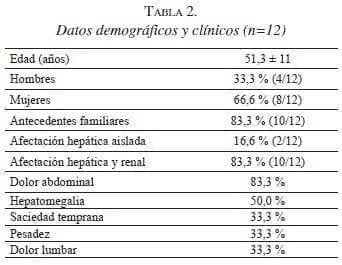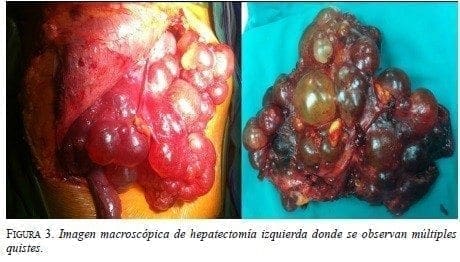
En los pacientes con afectación hepática, el síntoma más frecuente fue el dolor abdominal (83 %), seguido por hepatomegalia (figuras 1 y 2). La hepatectomía por cirugía abierta combinada con la fenestración, fue el procedimiento de elección en pacientes con saciedad temprana y hepatomegalia masiva (figura 3).

Conclusiones
La enfermedad poliquística hepática aislada es una enfermedad poco frecuente, en la cual el tratamiento quirúrgico está indicado para los pacientes sintomáticos; el procedimiento varía de acuerdo con el tamaño y la extensión de la afectación hepática, y puede ir desde la fenestración hasta la resección hepática anatómica.
El conocimiento actual sobre la cirugía hepática y el trasplante hepático, ha permitido tener buenos resultados en el tratamiento de esta enfermedad. La experiencia inicial en nuestra institución con esta enfermedad, ha mostrado buenos resultados con la implementación de hepatectomía por cirugía abierta combinada con la fenestración.
Surgical Treatment of Autosomic Polycistic Liver Disease, Case Series
Abstracts
Nowadays liver and biliary tract surgery are the most commonly performed procedures worldwide; refinement in surgical techniques, anesthetic care and liver transplantation have revolutionized the treatment of liver diseases that were previously incurable. The autosomal dominant polycystic liver disease is a rare condition that may be associated with polycystic kidney disease or can present alone; the symptoms of this condition occur in the advanced stages of the disease. Despite the multiple modalities of treatment available, surgery with hepatectomy and fenestration has shown better results in patients with early satiety and massive hepatomegaly.
A literature review was carried out and a number of cases dealt with this disease at the Metropolitan Hospital in Quito, Ecuador, are presented.
Key words: liver; polycystic; polycystic kidney, autosomal dominant; hepatectomy.
Bibliografía
1. Bristowe F. Cystic disease of the liver associated with similar disease of the kidneys. Trans Pathol Soc Lond. 1856;7:229- 34.
2. Kwok M, Lewin K. Massive hepatomegaly in adult polycystic liver disease. Am J Surg Pathol. 1988;12:321-4.
3. Melnick P. Polycystic liver; analysis of seventy cases. Arch Pathol. 1955;59:162-72.
4. Qian Q, Li A, King B, Kamath P, Lager D, Huston J 3rd, et al. Clinical profile of autosomal dominant polycystic liver disease. Hepatology. 2003;37:164-71.
5. Torres V, Harris P, Pirson Y. Autosomal dominant polycystic kidney disease. Lancet. 2007;369:1287-301.
6. Peters D, Sandkuijl L. Genetic heterogeneity of polycystic kidney disease in Europe. Contrib Nephrol. 1992;97:128-39.
7. Heggo O. A microdissection study of cystic disease of the kidneys in adults. J Pathol Bacteriol. 1966;91:311-5.
8. Verani R, Silva F. Histogenesis of the renal cysts in adult (autosomal dominant) polycystic kidney disease: A histochemical study. Mod Pathol. 1988;1:457-63.
9. Grantham J. Clinical practice: Autosomal dominant polycystic kidney disease. N Engl J Med. 2008;359:1477-85.
10. Bae K, Zhu F, Chapman A, Torres V, Grantham J, Guay-Woodford L, et al. Magnetic resonance imaging evaluation of hepatic cysts in early autosomal dominant polycystic kidney disease: The Consortium for Radiologic Imaging Studies of Polycystic Kidney Disease cohort. Clin J Am Soc Nephrol. 2006;1:64-9.
11. Grünfeld J, Albouze G, Jungers P, Landais P, Dana A, Droz D, et al. Liver changes and complications in adult polycystic kidney disease. Adv Nephrol Necker Hosp. 1985;14:1-20.
12. Gabow P, Johnson A, Kaehny W, Manco-Johnson M, Duley I, Everson G. Risk factors for the development of hepatic cysts in autosomal dominant polycystic kidney disease. Hepatology. 1990;11:1033-7.
13. Comfort M, Gray H, Dahlin D, Whitesell F Jr. Polycystic disease of the liver: A study of 24 cases. Gastroenterology. 1952;20: 60-78.
14. Drenth JP, Morsche RH, Smink R, Bonifacino JS, Jansen JB. Germline mutations in PRKCSH are associated with autosomal dominant polycystic liver disease. Nat.Genet. 2003;33:345-7.
15. Dávila S, Furu L, Gharavi A, Tian X, Onoe T, Qian Q, et al. Mutations in SEC63 cause autosomal dominant polycystic liver disease. Nat Genet. 2004;36:575-7.
16. Li A, Dávila S, Furu L, Qian Q, Tian X, Kamath P, et al. Mutations in PRKCSH cause isolated autosomal dominant polycystic liver disease. Am J Hum Genet. 2003;72:691-703.
17. Feldman M. Polycystic disease of the liver. Am J Gastroenterol. 1958;29:83-6.
18. Karhunen P, Tenhu M. Adult polycystic liver and kidney diseases are separate entities. Clin Genet. 1986;30:29-37.
19. Everson GT, Scherzinger A, Berger-Leff N, Reichen J, Lezotte D, Manco-Johnson M, et al. Polycystic liver disease: Quantitation of parenchymal and cyst volumes from computed tomography images and clinical correlates of hepatic cysts. Hepatology. 1988;8:1627-34.
20. Onori P, Franchitto A, Mancinelli R, Carpino G, Alvaro D, Francis H, et al. Polycystic liver diseases. Dig Liver Dis. 2010;42:261-71.
21. Redston M, Wanless I. The hepatic von Meyenburg complex: Prevalence and association with hepatic and renal cysts among 2843 autopsies corrected. Mod Pathol. 1996 9:233-37.
22. Kida T, Nakanuma Y, Terada T. Cystic dilatation of peribiliary glands in livers with adult polycystic disease and livers with solitary nonparasitic cysts: An autopsy study. Hepatology. 1992;16:334-40.
23. Lazaridis K, Strazzabosco M, Larusso N. The cholangiopathies: Disorders of biliary epithelial. Gastroenterology. 2004;127:1565-77.
24. Gaines P, Sampson M. The prevalence and characterization of simple hepatic cysts by ultrasound examination. Br J Radiol. 1989;62:335-7.
25. Caremani M, Vincenti A, Benci A, Sassoli S, Tacconi D. Ecographic epidemiology of non-parasitic hepatic cysts. J Clin Ultrasound. 1993;21:115-8.
26. Carrim Z, Murchison J. The prevalence of simple renal and hepatic cysts detected by spiral computed tomography. Clin Radiol. 2003;58:626-9.
27. van Keimpema L, de Koning D, Strijk S, Drenth J. Aspiration-sclerotherapy results in effective control of liver volume in patients with liver cysts. Dig Dis Sci. 2008;53:2251-7.
28. van Erpecum K, Janssens A, Terpstra J, Tjon A Tham RT. Highly symptomatic adult polycystic disease of the liver. A report of fifteen cases. J Hepatol. 1987;5:109-17.
29. Que F, Nagorney D, Gross J, Torres V. Liver resection and cyst fenestration in the treatment of severe polycystic liver disease. Gastroenterology. 1995;108:487-94.
30. Kabbej M, Sauvanet A, Chauveau D, Farges O, Belghiti J. Laparoscopic fenestration in polycystic liver disease. Br J Surg. 1996;83:1697-701.
31. Gigot J, Jadoul P, Que F, van Beers B, Etienne J, Horsmans Y, et al. Adult polycystic liver disease: Is fenestration the most adequate operation for long-term management? Ann Surg. 1997;225:286-94.
32. Qian Q. Isolated polycystic liver disease. Adv Chronic Kidney Dis. 2010;17:181-9.
33. Russell R, Pinson W. Surgical management of polycystic liver disease. World J Gastroenterol. 2007;13:5052-9.
34. Lin T, Chen C, Wang S. Treatment of non-parasitic cystic disease of the liver: A new approach to therapy with polycystic liver. Ann Surg. 1968;168:921-7.
35. Farges O, Bismuth H. Fenestration in the management of polycystic liver disease. World J Surg. 1995;19:25-30.
36. Konstadoulakis M, Gomatos I, Albanopoulos K, Alexakis N, Leandros E. Laparoscopic fenestration for the treatment of patients with severe adult polycystic liver disease. Am J Surg. 2005;189:71-5.
37. Martin I, McKinley A, Currie E, Holmes P, Garden O. Tailoring the management of nonparasitic liver cysts. Ann Surg. 1998;228:167-72.
38. Schnelldorfer T, Torres V, Zakaria S, Rosen C, Nagorney D. Polycystic liver disease: A critical appraisal of hepatic resection, cyst fenestration, and liver transplantation. Ann Surg. 2009;250:112-8.
39. Manterola C, Pineda V, Vial M. Efectividad del tratamiento laparoscópico de quistes y tumores hepáticos. Revisión global de la evidencia. Revista Chilena de Cirugía. 2007;59:264-71.
40. Robinson T, Stiegmann G, Everson G. Laparoscopic palliation of polycystic liver disease. Surg Endosc. 2005;19:130-2.
41. Hazbón H. Enfermedad poliquística del hígado. Rev Colomb Cir. 2008;23:168-73.
42. US Scientific Registry of Transplant: 2004 OPTN / SRTR Annual Report. US Organ Procurement and Transplantation Network and the Scientific Registry of Transplant Recipients. U.S. Government Sponsored Work, 2004. Fecha de consulta: 23 de septiembre de 2014. Disponible en: www.ustransplant.org
43. Takei R, Ubara Y, Hoshino J, Higa Y, Suwabe T, Sogawa Y, et al. Percutaneous transcatheter hepatic artery embolization for liver cysts in autosomal dominant polycystic kidney disease. Am J Kidney Dis. 2007;49:744-52.
44. Ubara Y, Takei R, Hoshino J, Tagami T, Sawa N, Yokota M, et al. Intravascular embolization therapy in a patient with an enlarged polycystic liver. Am J Kidney Dis. 2004;43:733-8.
45. Masyuk T, Masyuk A, Torres V, Harris P, Larusso N. Octreotide inhibits hepatic cystogenesis in a rodent model of polycystic liver disease by reducing cholangiocyte adenosine 3’,5’-cyclic monophosphate. Gastroenterology. 2007;132:1104-16.
46. van Keimpema L, de Man R, Drenth J. Somatostatin analogues reduce liver volume in polycystic liver disease. Gut. 2008;57:1338-9.
47. van Keimpema L, Drenth J. Effect of octreotide on polycystic liver volume. Liver Int. 2010;30:633-34.
48. van Keimpema L, Nevens F, Vanslembrouck R, van Oijen M, Hoffmann A, Dekker H, et al. Lanreotide reduces the volume of polycystic liver: A randomized, double-blind, placebo-controlled trial. Gastroenterology. 2009;137:1661-8.
49. Hogan M, Masyuk T, Page L, Kubly V, Bergstralh E, Li X, et al. Randomized clinical trial of long-acting somatostatin for autosomal dominant polycystic kidney and liver disease. J Am Soc Nephrol. 2010;21:1052-61.
50. Caroli A, Antiga L, Cafaro M, Fasolini G, Remuzzi A, Remuzzi G, et al. Reducing polycystic liver volume in ADPKD: Effects of somatostatin analogue octreotide. Clin J Am Soc Nephrol. 2010;5:783-9.
51. Shillingford J, Murcia N, Larson C, Low S, Hedgepeth R, Brown N, et al. The mTOR pathway is regulated by polycystin-1, and its inhibition reverses renal cystogenesis in polycystic kidney disease. Proc Natl Acad Sci USA. 2006;103:5466-71.
52. Wahl P, Serra A, Le H, Molle K, Hall M, Wuthrich R. Inhibition of mTOR with sirolimus slows disease progression in Han:SPRD rats with autosomal dominant polycystic kidney disease (ADPKD). Nephrol Dial Transplant. 2006;21:598-604.
53. Tao Y, Kim J, Schrier R, Edelstein C. Rapamycin markedly slows disease progression in a rat model of polycystic kidney disease. J Am Soc Nephrol. 2005;16:46-51.
54. Wu M, Wahl P, Le H, Wackerle-Men Y, Wuthrich R, Serra A. Everolimus retards cyst growth and preserves kidney function in a rodent model for polycystic kidney disease. Kidney Blood Press Res. 2007;30:253-9.
55. Wu M, Arcaro A, Varga Z, Vogetseder A, Le HM, Wüthrich R, et al: Pulse mTOR inhibitor treatment effectively controls cyst growth but leads to severe parenchymal and glomerular hypertrophy in rat polycystic kidney disease. Am J Physiol Renal Physiol. 2009;297:1597-1605.
Correspondencia: Andrés Ayala, MD
Departamento de Cirugía, Hospital Metropolitano
Correo electrónico: andres_pojkar@hotmail.com
Quito, Ecuador
